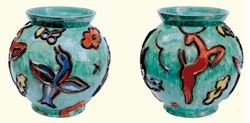Jolana Kirczová and modern Slovak ceramics
Martin Mešša
A picture of the between-the-wars artistic movements in Slovakia would not be complete without mentioning the interesting work of Jolana Kirczová, born Schwarzová (1909 – 1936). The small range of Kirczová’s work in ceramics is an expression of artistic opinions and influences similar to those that influenced the work of painters of Slovak modern. Nowadays we cannot say whether folk culture was a topic source for her on purpose or subconsciously. However, she used folk art in her compositions, in functionality and in shapes, and as a ceramic artist she was also inspired at a technological level. She is an exception to the then prevailing mechanical copying or use of folk ornaments on artistic works and various products that was supposed to give them folklore and nationality.
Kirczová bases her works on topics from sacral folk art – topics of Madonna inspire with folk pictures on glass. Kirczová’s artistic feelings were transferred to ceramic figures, sculptures and plaques, people and happenings in life from Drienov, were she lived, created and made her ceramics in a simple ceramic wood-burning oven over the period 1933 to 1939.
She was inspired by the internal power of the simple life; she was surrounded by folk songs and she then depicted this in her figures. Kirczová is not looking for monumentality: the folklore is expressed by the use of ornament, motifs found on folk embroidery or clothes, and her works are soaked in folklore and the life of the everyday village people of that time.
The short ceramic activity of Jolana Kirczová was, as proven by her works, a quest for new shapes, utility and unusual colour. Many works show that she matured into her artistic expression. Jolana Kirczová grew up in a cultivated family, well-oriented to art and supporting artists. Artists, mainly painters but also sculptors, immediately made an impression on the young Jolana during their stays at the Schwarz’s. From the age of 10 she visited the private drawing school of Eugen Krón in Košice. She continued in her artistic education in Budapest. During her short period of active ceramic activities in 1933 to 1936 she created a number of significant works proving her talent, individual approach, inspiration in folk art as well as echoes of the then artistic streams in Czechoslovakia and Europe.
